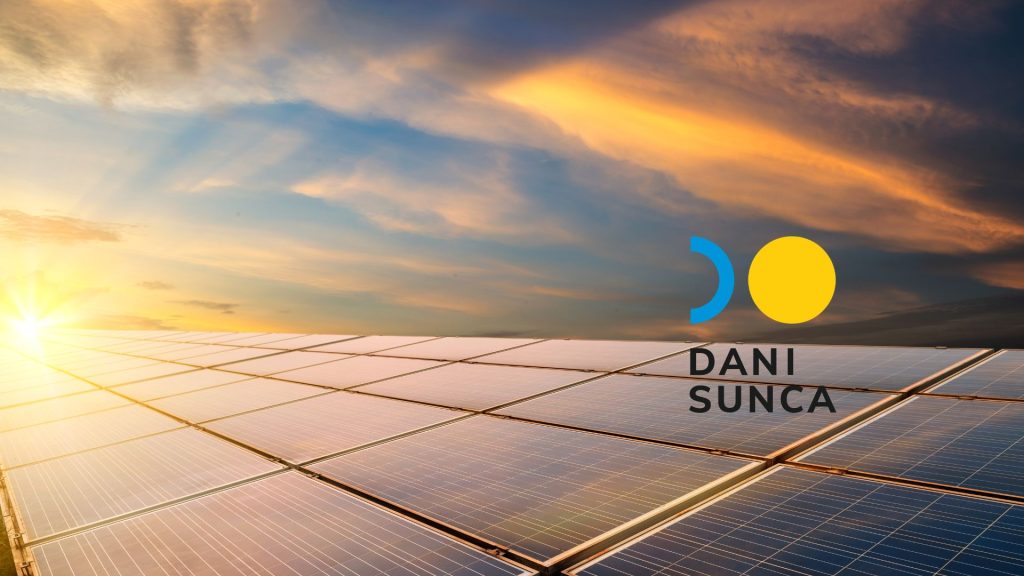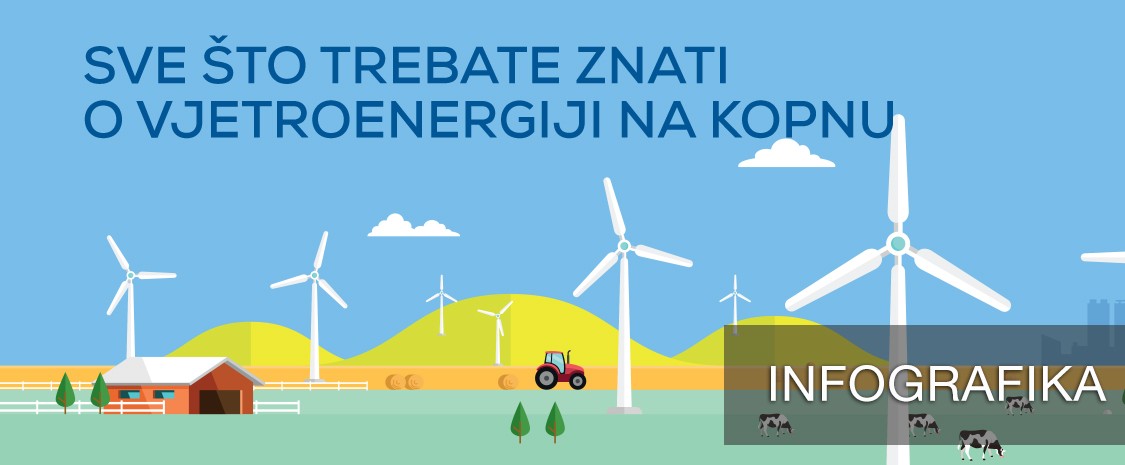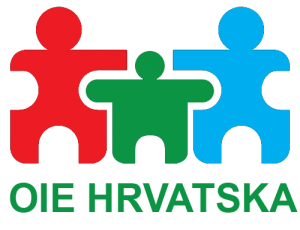Klimatske promjene utječu na sve aspekte naših života, a energetska tranzicija postala je imperativ modernog doba. No da tranzicija teče sporije od očekivanog, pokazala nam je energetska kriza prošle godine uzrokovana ratom u Ukrajini. Preko noći smo postali svjesni krhkosti naše energetske sigurnosti što nas je natjeralo da ozbiljnije promislimo o tome kako se kvalitetnije pripremiti za moguće buduće izazove. OIEH u ovoj analizi nudi moguća rješenja za postizanje 100% obnovljive energije u domaćoj proizvodnji do 2030., a time i ostvarenje energetske samodostatnosti.
Analiza je temeljena na detaljnom modeliranju evolucije proizvodnje i potrošnje električne energije te na brojnim simulacijama rada hrvatskog elektroenergetskog sustava u različitim vremenskim okvirima. Isto tako, predlaže načine za ubrzanje transformacije elektroenergetskog sustava do jačanja otpornosti na različite krize.
Ujednačenim rastom solarnih i vjetroelektrana do energetske neovisnosti
Na osnovu sadašnje potrošnje i trenda njenog rasta, kao i trenutno potrebnog uvoza električne energije, analiza pokazuje moguću energetsku sliku Hrvatske u 2030. godini uz 100% obnovljivu energiju. Godišnja potrošnja električne energije od 21 do 23 TWh godišnje bila bi zadovoljena proizvodnjom električne energije ponajviše iz sunčanih i vjetroelektrana u Hrvatskoj
Prvog siječnja 2030. godine Hrvatska bi prema ovom scenariju imala 2500 MW vjetroelektrana koje na godinu proizvode 6 TWh električne energije. Imala bi i 2500 MW sunčanih elektrana koje godišnje proizvode 3 TWh električne energije. Razvili bismo i 400 MW u ostalim projektima obnovljivih izvora energije poput biomase, bioplina i geotermalnih elektrana koje bi na godinu proizvodile 2 TWh električne energije.
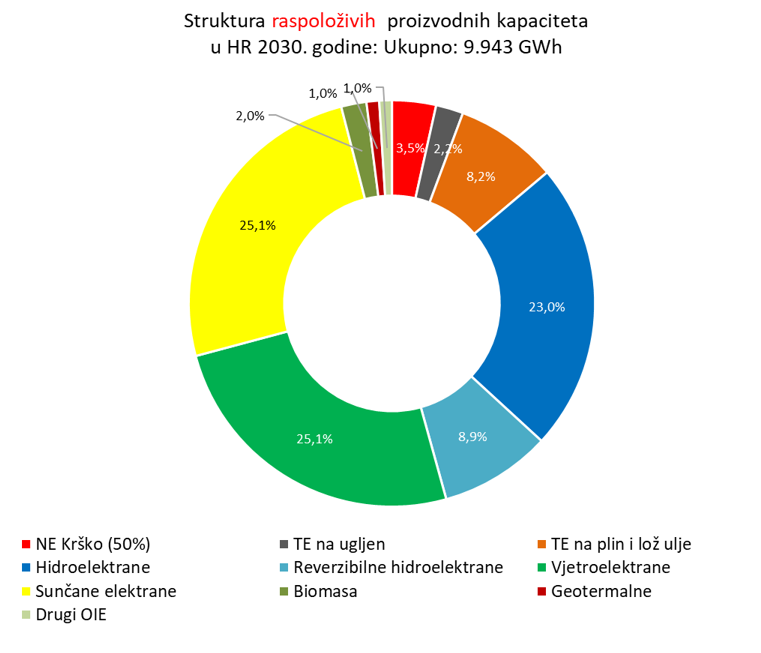
Tako bi u 2030. godini, uz prosječnu proizvodnju hidroelektrana od 6.344 GWh, ostali OIE proizveli oko 17 TWh, odnosno primarnu energiju od 42 TWh. To je jednako proizvodnji električne energije od 4,2 milijuna tona prirodnog plina ili 3,1 milijuna tona ukapljenog plina, 3,6 milijuna tona nafte, 5,9 milijuna tona kamenog ugljena, što je oko 42% sadašnje potrošnje primarne energije.
Očekuje se završetak izgradnje hidroenergetskog sustava Senj2/Kosinj snage 412 MW do 2029. godine s povećanjem godišnje proizvodnje na hidroenergetskom sustavu Senj za oko 220 GWh. Izgradnjom novih vjetro i sunčanih elektrana koje imaju promjenjivu i proizvodnju bit će potrebno do 2030. godine izgraditi i nove resurse fleksibilnosti za usluge sustava uravnoteženja na strani proizvodnje i strani potrošnje. To su nove reverzibilne hidroelektrane kapaciteta od +600/-600 MW, godišnje potrošnje od oko 2,5 TWh i proizvodnje neobnovljivih 1,875 TWh električne energije. Bit će potrebne i nove baterije za usluge skladištenja te usluge sustava uravnoteženja. Trebat će nam i stabilni i fleksibilni elektrolizatori za proizvodnju vodika koji bi skladištili viškove u sustavu kod velike proizvodnje HE, VE i SE.
Naravno, bitan uvjet za ovakvu energetsku sliku u 2030. godini je razvoj prijenosne i distribucijske mreže. Posebno treba izdvojiti razvoj novog dvostrukog dalekovoda od 400 kV, prijenosnog kapaciteta oko 2500 MW, između Dalmacije i sjevernozapadne Hrvatske. Uz sve navedeno bio bi to najbolji scenarij elektroenergetske strategije razvoja u srednjoročnom razdoblju, koja počiva na 100% OIE, no zahtijeva velika investicijska ulaganja, ali daje male operativne troškove (cijene električne energije) u pogonu.
Ulaganja potrebna za ostvarenje energetske samodostatnosti
Ulaganja potrebna za dostizanje ovih energetskih ciljeva kreću se oko jedne milijarde eura na godišnjoj razini. Od toga bi 500 milijuna eura bilo potrebno za izgradnju solarnih i vjetroelektrana, 300 milijuna za rehabilitaciju, modernizaciju rekonstrukciju, zamjene i digitalizaciju elemenata prijenosne i distribucijske mreže, 200 milijuna za tehnologije skladištenja (RHE nove tehnologije, baterije i vodik). Ovo je financijski dostupan cilj i čini 1,62% BDP-a koji je iznosio 61,892 milijardi eura u 2022. godini u Hrvatskoj. Tako bismo ispunili sve uvjete EU za razvoj i dekarbonizaciji energetskog sektora koji su naglašeni planom REPowerEU. Hrvatska to može ostvariti bez mnogo poteškoća.
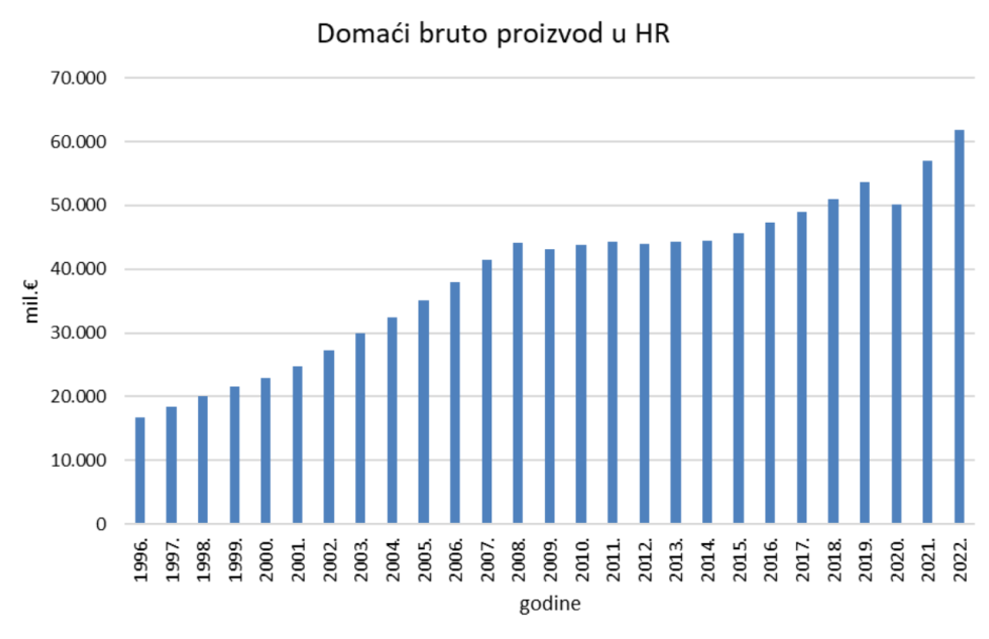
Obilje sunčanih elektrana u 2030.
Hrvatska prema ovoj analizi može i treba imati obilje megavata sunčanih elektrana. Kako bi izgledala elektroenergetska bilanca na godišnjoj i mjesečnoj razini u 2030. godini, uz pretpostavku godišnje potrošnje konzuma od 22.618 GWh (viši scenarij rasta) i potrošnje RHE u crpnom pogonu od 2.413 GWh, te prosječnu hidrologiju, vjetrovitost i oblačnost uz zadržavanje postojećih raspoloživih proizvodnih kapaciteta – prikazano je na slijedećim slikama:

Vidljiva je uravnotežena elektroenergetska bilanca uz mali uvoz, kao i smanjena proizvodnja termoelektrana i ostalih elektrana na fosilna goriva, smanjenje emisija CO2 te velika proizvodnja OIE.
Bez uvoza uz proizvodnju iz obnovljivih izvora energije
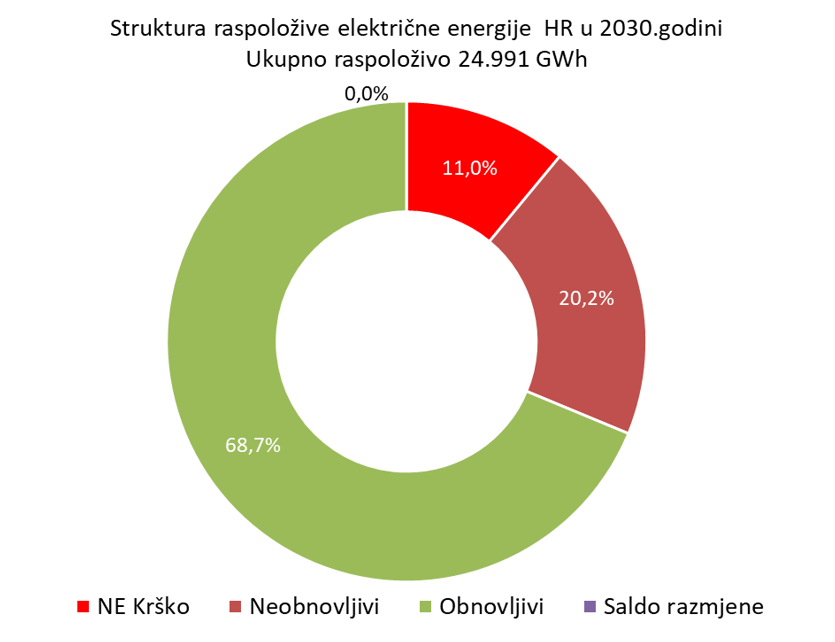
Prema kategorijama raspoložive energije u 2030. godini obnovljivi izvori energije sudjeluju s 68,7% u proizvodnji električne energije, neobnovljivi s 20,2% i nuklearna elektrana Krško(50%) s 11%. Saldo razmjene je nula, odnosno elektroeneregtska bilanca bi bila u potpunosti uravnotežena. Uvoz nam prema ovom scenariju neće biti potreban u 2030. godini.
Treba naglasiti da među neobnovljivim izvorima reverzibilne hidroelektrane u proizvodnji električne energije sudjeluju sa 7,8%, a termoelektrane na fosilna goriva s 12,4%. Sveukupna raspoloživa energija bila bi „opterećena“ proizvodnjom CO2 od 81g/kWh što bi Hrvatsku u 2030. godini svrstalo među zemlje EU s najvećom ostvarenom dekarbonizacijom.
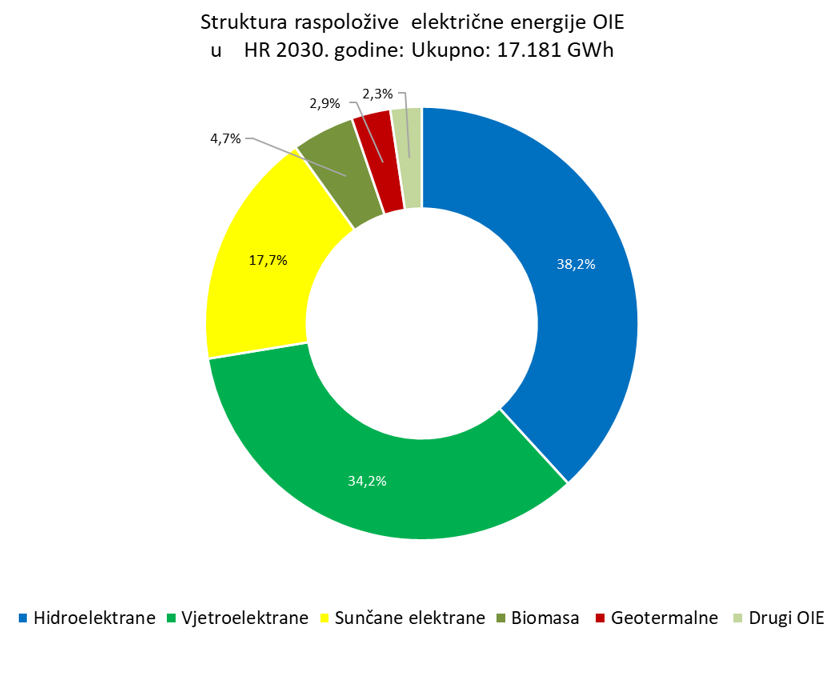
Hidroelektrane bi i dalje proizvodile najviše obnovljive električne energije, ali bi ih vjetroelektrane u daljnjem razvoju pretekle već do 2035. godine. Na donjoj je slici vidljiva ravnomjerna proizvodnja OIE tijekom 2030. godine kao i velika proizvodnja iz solarnih elektrana posebno ljeti kada je smanjena proizvodnja hidroelektrana, što je cilj koji bismo voljeli vidjeti i prije 2030. godine.

Na osnovu mjesečnih bilanci vidljiva je proizvodnja vjetroelektrana i hidroelektrana koje više energije proizvode u jesensko-zimskoj sezoni, dok na mjesečnom nivou sunčane elektrane proizvode najviše energije u proljetno-ljetnoj sezoni, odnosno oko 70% godišnje proizvodnje u razdoblju travanj-rujan. Tako se dobiva ravnomjernija mjesečna proizvodnja, a time i sigurnija opskrba potrošača i rada elektroenergetskog sustava.
Formiranje virtualne elektrane
Analiza sadašnjih trendova predviđa kako emisije stakleničkih plinova nastavljaju rasti do 2030. uz istovremeni porast temperatura diljem svijeta. Zato je od presudne važnosti ubrzanje energetske tranzicije što podrazumijeva promjenu naših obrazaca potrošnje i proizvodnje energije. Jasno je da obnovljivi izvori energije ovise o vremenskim prilikama te ne mogu uvijek proizvesti istu količinu električne energije. Zbog toga je važno stvoriti sustav od više proizvođača i potrošača električne energije koji upravljaju potrošnjom te u prema potrebi vraćaju stabilnost elektroenergetskom sustavu. Virtualne elektrane su upravo takav sustav gdje su svi subjekti uključeni i svi ostvaruju korist. Prema definiciji, virtualna elektrana – VPP (Virtual power plant) predstavlja sustav zasnovan na softveru i tehnologiji pametnih sustava, kojim se vrši automatsko, daljinsko upravljanje agregiranim resursima s ciljem pružanja usluga na veleprodajnom ili maloprodajnom tržištu posredstvom platforme za agregiranje i optimizaciju.

Srpanj 2030. godine: Simulacija rada VE 2500 MW s prosječnim faktorom snage i SE 2500 MW na osnovu nadomjesne krivulje s prosječnom oblačnošću na satnom nivou.
Izgradnjom 2500 MW vjetroelektrana i sunčanih elektrana te nove RHE snage +600/-600 MW nove tehnologije do 2030. može se formirati virtualna elektrana s ili bez RHE Velebit koja bi u sustav davala vrlo pouzdanu, predvidljivu, stabilnu i upravljivu energiju. Plan i rad ove virtualne elektrane može se potpuno pogonski digitalizirati. Na donjoj slici je prikazan rad sustava s virtualnom elektranom te simulacija za srpanj 2030.godine.
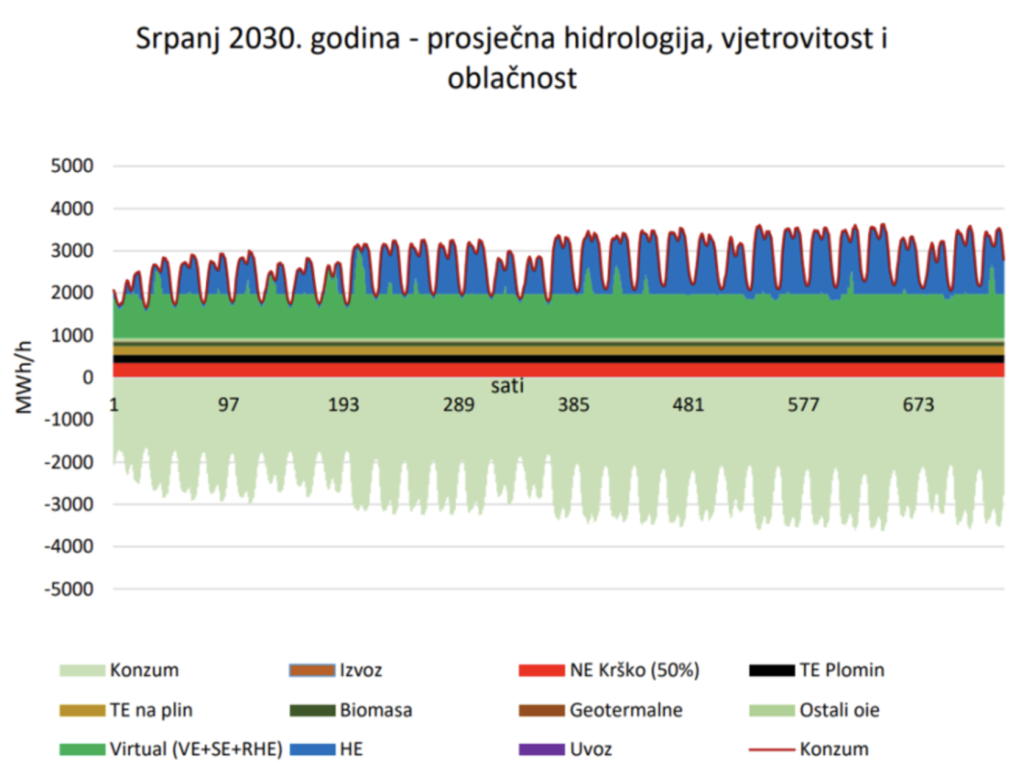
Srpanj 2030. godine: Virtualna elektrana koja upravlja s 2500 MW VE, 2500 MW SE i RHE nova 600/-600 MW te RHE Velebit 276/-240 MW, u prosjeku raspolaže s 1.072 MWh/h što je 3,1 puta više od hrvatskog dijela NE Krško (50 %).
Rad virtualne elektrane ima funkciju pretvaranja promjenjive proizvodnje vjetro i sunčanih elektrana u pouzdanu i stabilnu, te uravnoteženje elektroenergetskog sustava i osiguranje rada termoelektrana na optimalnim pogonskim točkama.
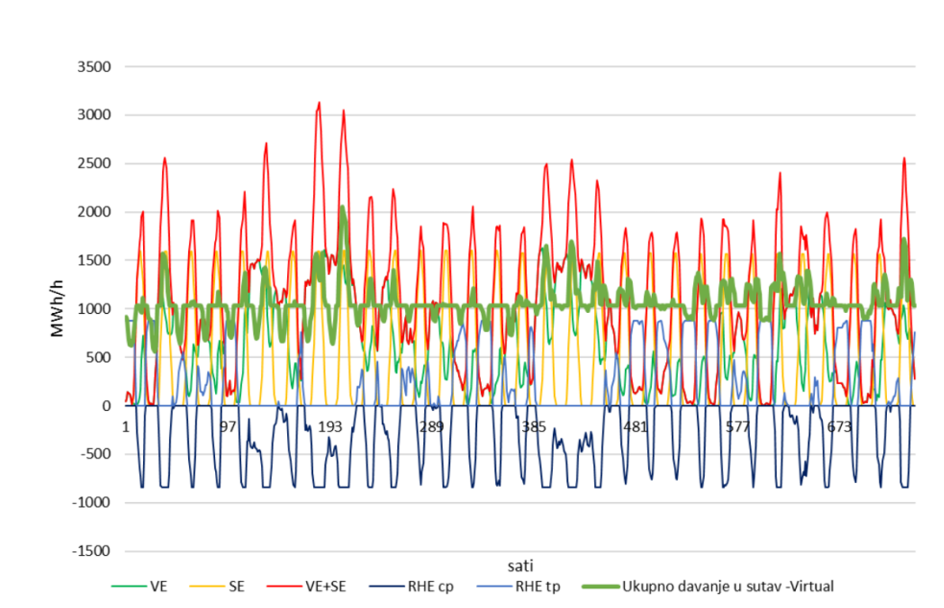
Na gornjoj je slici vidljivo kako u srpnju 2030. godine virtualne elektrane pretvaranju proizvodnju VE i SE u pouzdanu i stabilnu proizvodnju.
DANI SUNCA 2023.
Danas više nema dvojbe o dugoročnom napuštanju energije fosilnih goriva na temelju velikih promjena u obrascima potrošnje i proizvodnje energije, kako bi se ograničili učinci klimatskih promjena, ali i povećao hrvatski energetski suverenitet.
Analize hrvatske potrošnje, proizvodnje i razmjene električne energije sa susjednim zemljama provode se na preciznoj vremenskoj skali i ažuriraju svaki mjesec. Zahvaljujući ovakvim analizama moguće je predvidjeti buduće scenarije razvoja našeg elektroenergetskog sustava koji mogu postati ključan alat za upravljanje i planiranje razvoja elektroenergetskog sustava.
Već se sad nameće zaključak da je dostizanje ciljeva energetske samodostatnosti moguće uz novu RHE snage 600/-600 nove tehnologije, 2500 MW vjetroelektrana i 2500 MW sunčanih elektrana. Hrvatska to može ostvariti bez većih problema.
Rješenja za ubrzani razvoj Hrvatskoj prijeko potrebnih novih sunčanih elektrana prezentirat ćemo na konferenciji DANI SUNCA u Bolu na Braču 25-26. svibnja. Snažniji razvoj solarnih elektrana, primjena agrosolara, uključivanje energetskih zajednica u solarne projekte, definiranje “Go-to” područja za ubrzani razvoj obnovljivih izvora energije samo su neke od tema važnih za brži razvoj solarnih projekata i postizanje ciljeva energetske samodostatnosti o kojima ćemo govoriti na konferenciji.
Konferencija DANI SUNCA neizostavna je za sve one koji teže boljem korištenju sunčeve energije i razvoju novih megavata solarnih elektrana! Interes za sudjelovanjem je iznimno velik, rezervirajte svoje mjesto na vrijeme! Prijaviti se možete OVDJE.
